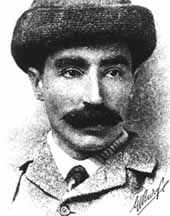
There are not as many travel accounts by Western authors visiting the Middle East as sand particles in the great Arabian desert, but the number is considerable just the same. One of the younger visitors, arriving in the British held port of Aden in 1896, at the age of 22 was G. Wyman Bury, whose intrigues and failed attempt to navigate the so-called “Empty Quarter†left him a broken man and brought him to an early death at age 46. It did not start out that way. Spending a year in Morocco, the young English lad described himself there as a “callous youth just out of his teens dropping in haphazard on a real tribe accompanied by a mission-taught Moor and a large liver-coloured pointer who had more sense than his master.â€
In Yemen the slowly maturing man was adopted into the ‘Abdali tribe of South Yemen with the name of Abdullah Mansour and he soon took to wearing local dress. Here is how he describes one of his colorfully remembered encounters:
Surmounting this last crest, we saw below us to the N.N.E. the green râk bushes of Bêhân valley winding through the desert. The upper reaches and permanent settlements were hidden from us by the hill-spurs which guard its right bank; while away in the distance beyond rose other systemsd towards Harîb and Mareb on the Yaman border. We mounted and rode down the slope as the sun sank low on the left.
Were certain precautions were essential unless we wanted our future hosts to ‘come for’ us, for we looked the very image of a raiding party; so the âkil sent forward two of his men with a note from me, backed by the Farîds and himself.
Meanwhile we sat down under the lee of a râk-bush on the outer verge of the valley, and unveiling our faces, tried to get some of the sand out of our eyes. I never say such a crew, and sincerely trusted that the Sharîf’s folk were not given to hasty judgment from outward semblance only, or they’d shoot on sight. Even the Hamdân looked haggard and less stately than his wont, and as for the asâkir [soldiers], the Farîds and myself – well, a more unkempt desperate-looking set of ruffians could not have been readily found even in Arabia.
The Farîds sat laughing at each other and at me.
‘O, Abdullah, if you could but see yourself! Why, the very dogs at Dar Mansûr would bark at you.’ I drew a little heliostat-mirror from the breast pocket of my embroidered jacket and investigated my appearance, which fairly startled me. I had kept my beard in decent trim, but had allowed my hair to grow Bedouin-fashion, in order to avoid colds when sleeping in the open at high altitudes. It drooped in unseemly waves nearly to my shoulders. Like all the rest, I had the usual ‘desert-stare’ (sunken eyes and over-hanging brows), with a sand-peppered swart complexion of duskier hue than most of the Nisâbas… Our faces were all sharp-featured and grimly set, and what with pinched prominent noses and emaciated frames, we looked a villainous and abandoned set of crocks whom a medical man would probably have sized up at a glance as ‘badly nourished and on the verge of collapse from fatigue and thirst.’ As a matter of fact, we were going strong, while our ‘mounts’ had stuck to their text well, like the gallant beasts they were, both ponies and camels; and when our messengers returned from the valley with friendly greetings, we moved in on the Sharîf’s grazing camp in style.â€
[Excerpts from G. Wyman Bury, The Land of Uz (London, MacMillan, 1911), pp. 251-252.]